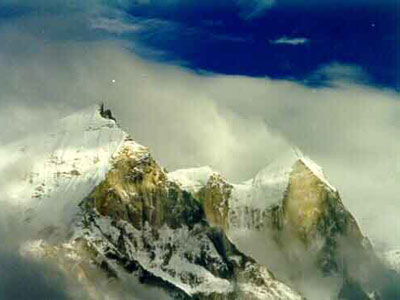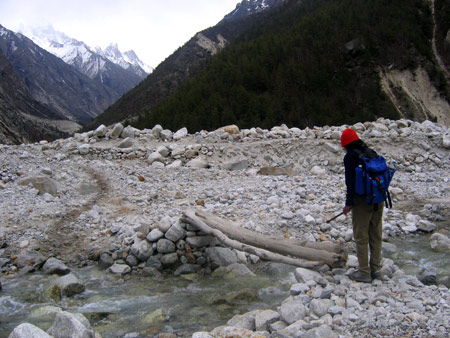| Environment Himalayas: An Impending Catastrophe
|
|||||
Journalists from five Himalayan states of Uttarakhand, Jammu and Kashmir, Himachal Pradesh, Arunachal Pradesh and Assam came together at a media briefing workshop organized by Centre for Science and Environment at Forest Research Institute, Dehradun. |
Environment | ||||
 Richard Mahapatra, Managing Editor of Down To Earth, CSE's fortnightly magazine said: "All of us know that Himalayas are the world's youngest mountain range, and landslides and other natural disasters happen here regularly. It is an extremely vulnerable region. What are the factors that have made this region more fragile? Firstly, climate change-related extreme weather events, like the floods that have ravaged Uttarakhand or Jammu and Kashmir. Secondly, our uncontrolled efforts to 'develop' the region: an abundance of roads, dams, cities, buildings have compounded the problems in this region."
Richard Mahapatra, Managing Editor of Down To Earth, CSE's fortnightly magazine said: "All of us know that Himalayas are the world's youngest mountain range, and landslides and other natural disasters happen here regularly. It is an extremely vulnerable region. What are the factors that have made this region more fragile? Firstly, climate change-related extreme weather events, like the floods that have ravaged Uttarakhand or Jammu and Kashmir. Secondly, our uncontrolled efforts to 'develop' the region: an abundance of roads, dams, cities, buildings have compounded the problems in this region." Anumita Roychowdhury, CSE's Executive Director - Research & Advocacy, stressed: "The Himalayas will always remain vulnerable. Development here will not work if we do not remember that and take the true nature of the region into account. For instance, building in this region without keeping its seismicity in mind can have disastrous results, especially when predicting earthquakes is still a very uncertain science." The Himalayas have a profound effect on the climate of the Indian subcontinent and the Tibetan Plateau. They prevent frigid, dry winds from blowing south into the subcontinent, which keeps South Asia much warmer than corresponding temperate regions in the other continents. It also forms a barrier for the monsoon winds, keeping them from travelling northwards, and causing heavy rainfall in the Terai region.
As the effects intensify in the coming decades, they will have unimaginable impact on water, food, and energy security for humans as well as on bio-diversity and loss of species. The prospects ahead are grim. Do we give up trying, or do we try a little harder to create awareness of what we are collectively doing every day through our ignorance, our apathy and our willful acts of degradation? Else the earth we have inherited from our ancestors will not allow our descendants to survive.
In Uttarakhand, politician, bureaucrat and citizen alike turn a blind eye to the indiscriminate illegal mining, tree felling, forest fires. There have been recent media reports of 3,600 ghost villages of the 16,000 villages in the state, where villagers have left in search of better prospects, because there is no education for their children, no medical facilities, and virtually no governance in the state. It is the only Indian state where the rural areas are administered not by civil police but by revenue police, ill-equipped to handle crime. There is total indifference to the plight of the local population, compounded by the reverse migration with locals leaving their state and people from cities in other states, building inappropriate 'mansions', on hill slopes that have been bulldozered by JCBs, on agricultural land, where no building plans or permissions are required, where there is an acute scarcity of water supply, where homes are given a 2 KVA permissible load. Kedarnath was one tragedy. Others likely await Uttarakhand.
Similar destruction is clearly visible in Ladakh, the high Himalayan cold desert. There is explosive growth of tourism from 527 tourists in 1974 to 79,000 in 2009, reportedly 2 lakh tourists in 2012, and growing exponentially. Tourist to Local ratio is 5:1. This creates enormous pressure on the ecologically fragile environment. Few of the 400-odd hotels and guest houses in Ladakh have a sewage disposal system. Because of major electricity shortage, hotels, restaurants, shops and commercial enterprises catering to tourists use highly polluting diesel generators for hours every day. What is the effect on the surrounding glaciers and endangered animals like the snow leopard and the red deer, in the state's protected forests? Everywhere in the Himalayas, there is an imbalance. In many mountain areas, concern has grown about the negative impacts of tourism, one of the fastest growing industries, on the natural environment, village economies and cultural traditions. Those who want to 'enjoy' the Himalayas, are not committed to and invested in the area. Uninformed and callous tourists, vacation-time residents, mercenaries, land-sharks and opportunists ravage and plunder the fragile Himalayas. They do not respect the people and the land, the culture and the ethos in these fragile ecosystems that are undergoing rapid and drastic change. The Himalayas, long regarded as the abode of the gods, is the third pole, as the third largest depository of ice and snow in the world, after Antarctica and the Arctic. It is not environmentalists who are crying themselves hoarse anymore. The local people are not raising their voices in protest. Nature itself has chosen to correct the imbalances, and man may have little say in the matter as earthquakes, landslides, extreme weather conditions, floods, droughts virtually close the Himalayas to people.
Reference Sources:
Presentations at the Conference
Other Sources
|
|||||
Editor: Romola Butalia (c) India Travelogue. All rights reserved. |
|||||
 There are few regions where the impact of climate change is being felt as strongly, and where climate change will likely be as rapid and drastic as the Himalayas, with severe consequences on biodiversity, ecosystems and human welfare. The Himalayas have the highest concentration of glaciers with some 15,000 glaciers and are the source of nine major river systems. People in nine countries rely on Himalayan glaciers to provide much of the water that feeds China, India, Vietnam, Laos, Thailand, Burma, Nepal, Bhutan and Pakistan.
There are few regions where the impact of climate change is being felt as strongly, and where climate change will likely be as rapid and drastic as the Himalayas, with severe consequences on biodiversity, ecosystems and human welfare. The Himalayas have the highest concentration of glaciers with some 15,000 glaciers and are the source of nine major river systems. People in nine countries rely on Himalayan glaciers to provide much of the water that feeds China, India, Vietnam, Laos, Thailand, Burma, Nepal, Bhutan and Pakistan. What are the implications of the hydro-electric projects In Arunachal Pradesh? Despite election campaign assurances to the people of Arunachal Pradesh that small projects would be preferred to large dams, the ministry of environment, forest and climate change has granted environmental clearance to the controversial 2,880 MW Dibang Multipurpose Project, pegged at Rs 25,000 crores, developed by the National Hydroelectric Power Corporation Limited, to be completed over nine years. A vast forest area of 4,500 hectares will be submerged due to the project. During construction, an estimated 32 lakh truckloads of boulders and 16 lakh truckloads of sand would be extracted from the Dibang river basin, according to South Asian Network on Dams, Rivers and People (SANDRP). Approximately 198 lakh cubic metres of muck would be disposed in the river bank, further impacting 120 hectares of the river. Will it make the area more prone to landslides and flash floods? How will it impact the animals in Mehoa Wildlife Sanctuary and Dibru Saikhowa National Park?
What are the implications of the hydro-electric projects In Arunachal Pradesh? Despite election campaign assurances to the people of Arunachal Pradesh that small projects would be preferred to large dams, the ministry of environment, forest and climate change has granted environmental clearance to the controversial 2,880 MW Dibang Multipurpose Project, pegged at Rs 25,000 crores, developed by the National Hydroelectric Power Corporation Limited, to be completed over nine years. A vast forest area of 4,500 hectares will be submerged due to the project. During construction, an estimated 32 lakh truckloads of boulders and 16 lakh truckloads of sand would be extracted from the Dibang river basin, according to South Asian Network on Dams, Rivers and People (SANDRP). Approximately 198 lakh cubic metres of muck would be disposed in the river bank, further impacting 120 hectares of the river. Will it make the area more prone to landslides and flash floods? How will it impact the animals in Mehoa Wildlife Sanctuary and Dibru Saikhowa National Park?  While the media focuses primarily on insurgency and the political instability in Kashmir, environmental issues have taken a backseat. Dal Lake is perhaps beyond redemption. Tons of raw sewage and untreated waste from house-boats and hotels on its banks have converted this scenic lake into an oversized septic tank. People have been constructing colonies of permanent houses on islands in the very heart of the lake. The non-biodegradable garbage dumped by pilgrims to Amarnath Cave and Vaishno Devi, is the untold story of all pilgrim routes in our country.
While the media focuses primarily on insurgency and the political instability in Kashmir, environmental issues have taken a backseat. Dal Lake is perhaps beyond redemption. Tons of raw sewage and untreated waste from house-boats and hotels on its banks have converted this scenic lake into an oversized septic tank. People have been constructing colonies of permanent houses on islands in the very heart of the lake. The non-biodegradable garbage dumped by pilgrims to Amarnath Cave and Vaishno Devi, is the untold story of all pilgrim routes in our country.